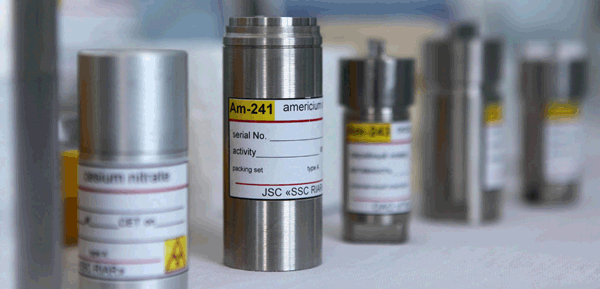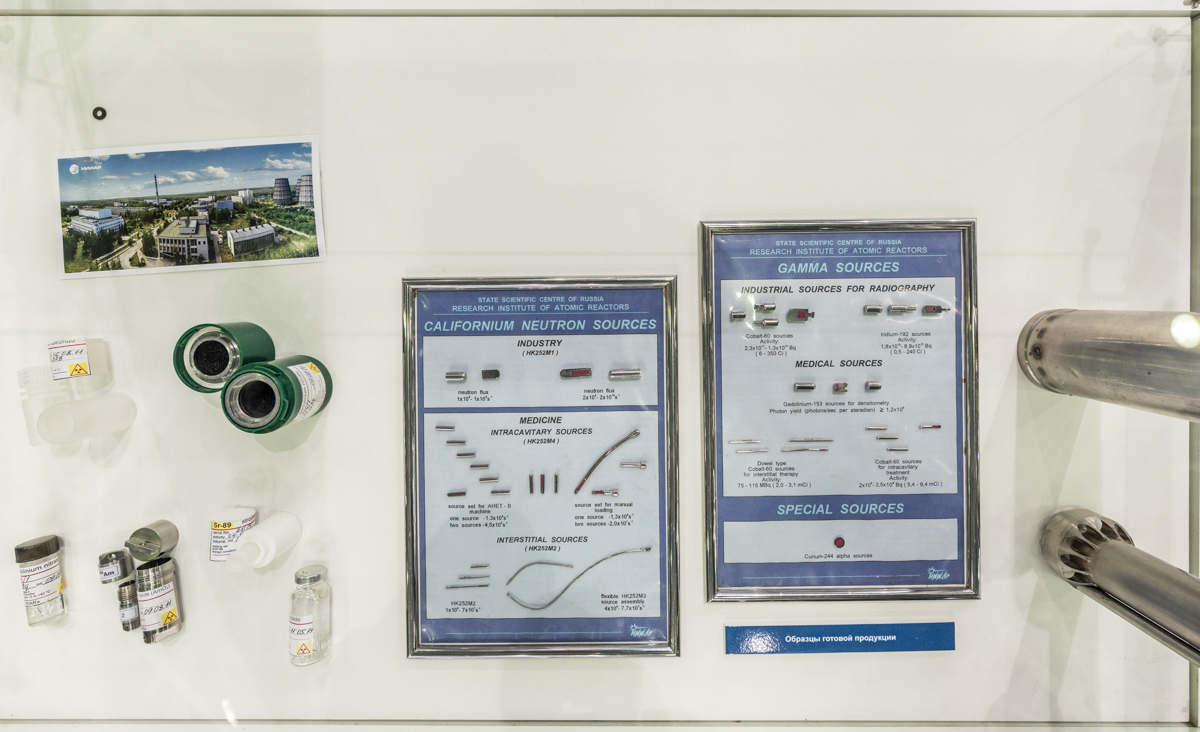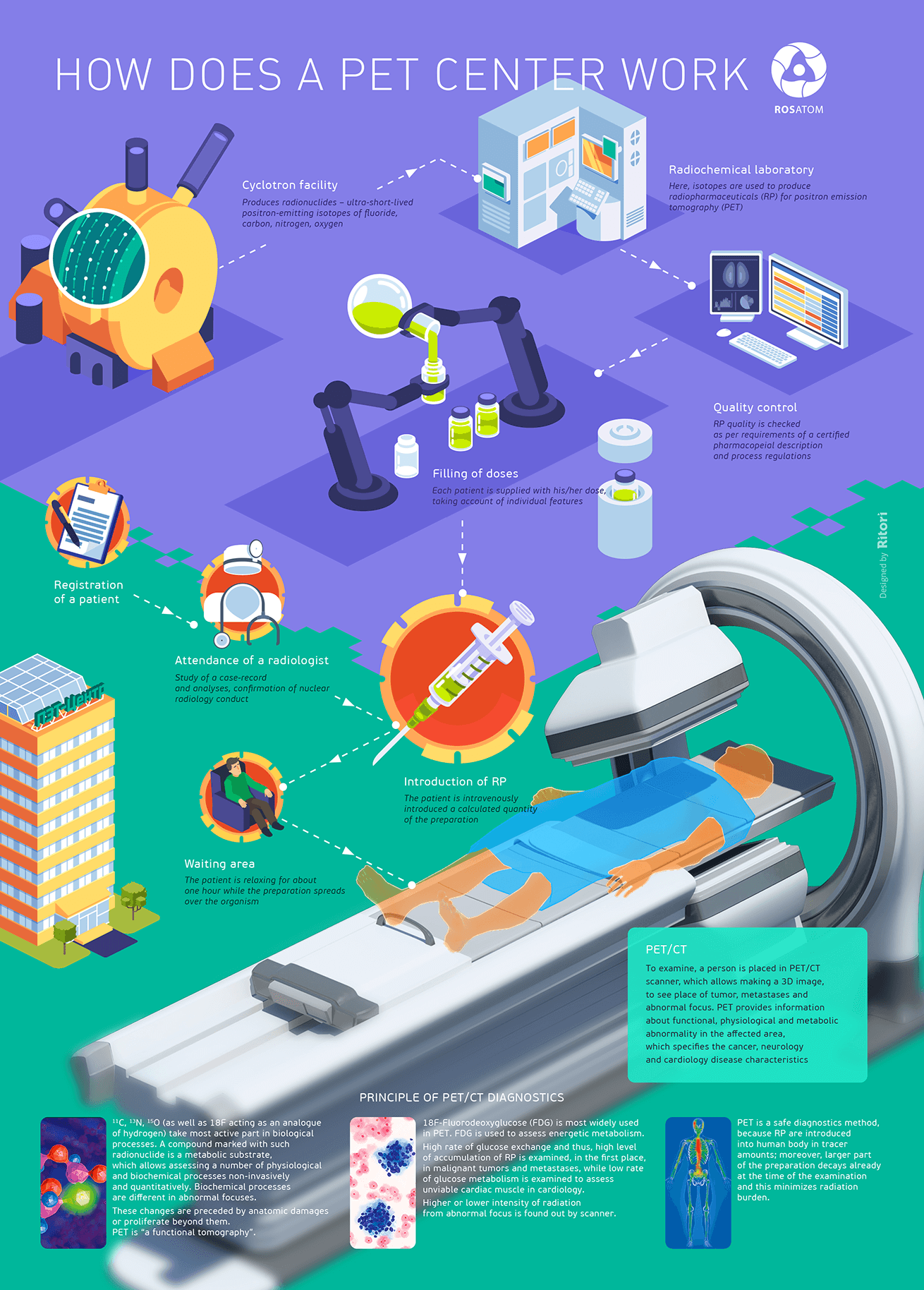One of the activities of the state corporation Rosatom is the development of nuclear medicine (medical diagnostics and radiation therapy, used for the treatment of oncological diseases). In cooperation with the Russian Federal Biomedical Agency and leading producers, Rosatom is developing a medical production complex, from the production of isotopes to effective medical treatment with the use of domestic equipment. It is proposed that a federal network of medical centres be established in Russia, where the most modern and accurate diagnostics of serious conditions will be conducted by using a combined positron-emission, and computed tomography technique.

Today over 50 % of radioactive isotopes produced in the world are used for medical purposes. Within the confines of Rosatom’s activities around the development of nuclear medicine nationwide, Rosatom set up production of the isotope Molybdenum-99 in the State Scientific Centre - the Scientific Research Institute for Nuclear Reactors (known as NIIAR) (in Dimitrovgrad, in the Ulyanovsk region). Molybdenum-99 is used for the production of Technetium-99m (Tc-99m) generators, this being the main diagnostic radionuclide in modern nuclear medicine, and is supplied not only to Russian customers but also to foreign markets. Currently Tc-99m is used to diagnose a number of human illnesses, first and foremost, oncological and cardiovascular.
Other contemporary medical isotopes are being developed and produced at the NIIAR site: Iodine-131, Iodine-125, Tungsten-188, Strontium-89, Tungsten-188 (a Rhenium-188 generator), and Lutetium-177, etc.
In addition, over 60 % of Russian isotope products are produced at the PO (Production Association) Mayak, which is the world’s largest producer of gamma-irradiation sources based on Cesium-137 and which produces 30 % of the available sources based on Cobalt-60. This is the only site at which Plutonium-238 is produced, as well as fast neutron sources based on Americium-241 and a wide range of unique products. The plant annually produces several thousand ionizing radiation sources and radioactive compounds. Over 90% of the products are exported.

The wide range of isotope products produced at Russian enterprises is achieved by different enterprises specialising in various production techniques. The Electrochemical Plant (Elektrokhimicheskiy Zavod) and Siberian Chemical Plant (Sibirskiy Khimkombinat) use the gas-centrifuge separation method to obtain stable isotopes. This enables the plant to produce products with the optimum level of enrichment and chemical purity. Along with that, the Electrochemical Plant is the world’s largest producer of stable isotopes. Elektrokhimpribor produces stable isotopes by means of electromagnetic separation. In addition to the industrial facility, the enterprise also houses an experimental facility, which, at the request of the customer enables production of a small batch of products. The Leipunsky Institute of Physics and Power Engineering produces radioactive isotopes by irradiating stable isotopes in a reactor.
Equipment based on isotope micro-sources is also being developed. The first operation using brachytherapy (a type of radiation therapy used to treat oncological diseases) - in this case a malignant tumor in the prostate was performed using solely Russian micro-sources of the isotope Iodine-125 in 2015 in the A.F. Tsyba Medical Radiological Research Centre (in Obninsk), a branch of the National Research Medical Radiology Centre of the Ministry of Health. This was a milestone in a project, which began 10 years ago. The isotope Iodine-125 is produced at RIAR in the required quantity, and the micro-sources with isotopes are produced by the Leipunsky Institute of Physics and Power Engineering (in Obninsk). The micro-sources (grains) developed in IPPE are much cheaper than their foreign counterparts, and enable critical life saving operations to be conducted within the budgetary funds allocated by the State.
Another area of Rosatom activities in the field of nuclear medicine is the production of tomographic scanners and therapeutic accelerators. In particular, the Research Institute of Electrophysical Apparatus (NIIEFA) developed the Efatom gamma-tomographic scanner, which can be used in the diagnosis of a wide range of illnesses. The gamma-chamber of the device does not concede in terms of its clinical parameters to foreign analogues. It is proposed that serial production of this scanner will begin in the near future.
NIITFA developed a new generation of AGAT-SMART gamma-therapeutic contact ray therapy apparatus. The AGAT integrated apparatus, incorporating a gamma-ray source with a diagnostic table, which was adapted for the design of the X-ray unit, a planning system, and a C-arc type X-ray unit ensures implementation of pre-irradiation preparation technology as well as ensuring irradiation in the same location by establishing a local network: the image processing system on the X-ray unit – the dosimetric planning system – and the gamma apparatus control system. The characteristic features of this equipment are: the fact that it is simple to control, it enables the development of irradiation plans, its ease of maintenance, as well as operational reliability and safety, which is very important for its large-scale implementation and trouble-free operation in the country’s oncology institutes.
Non-nuclear equipment manufacturing

